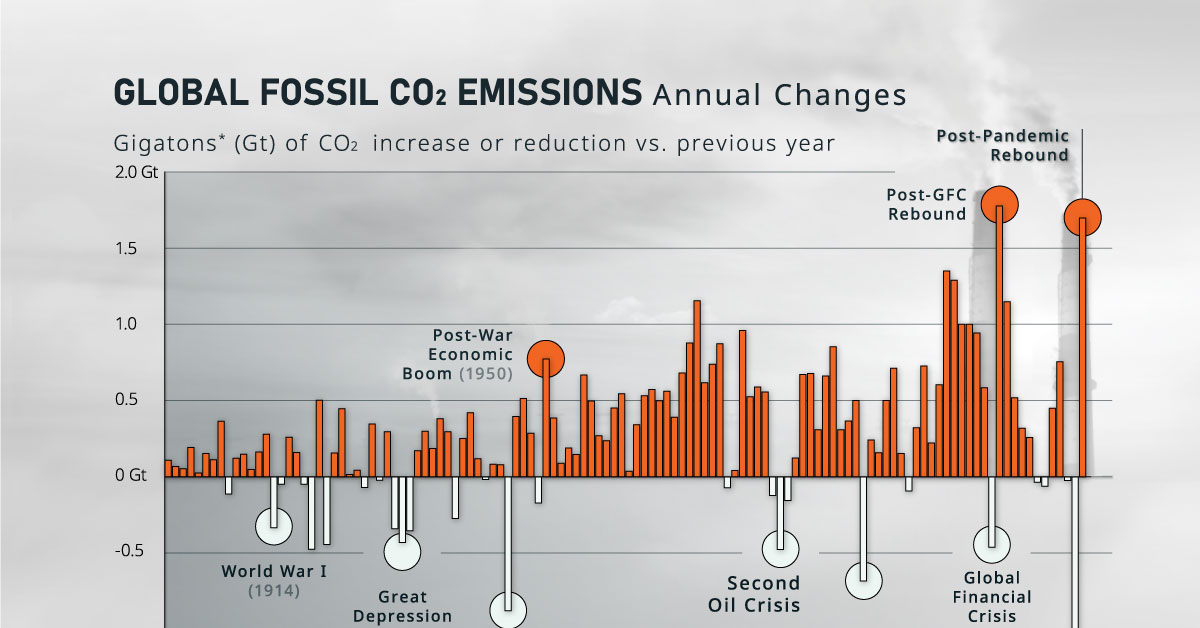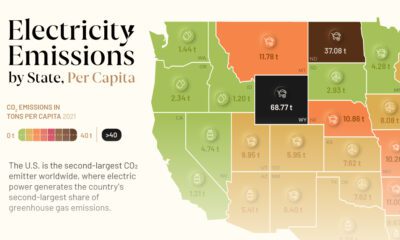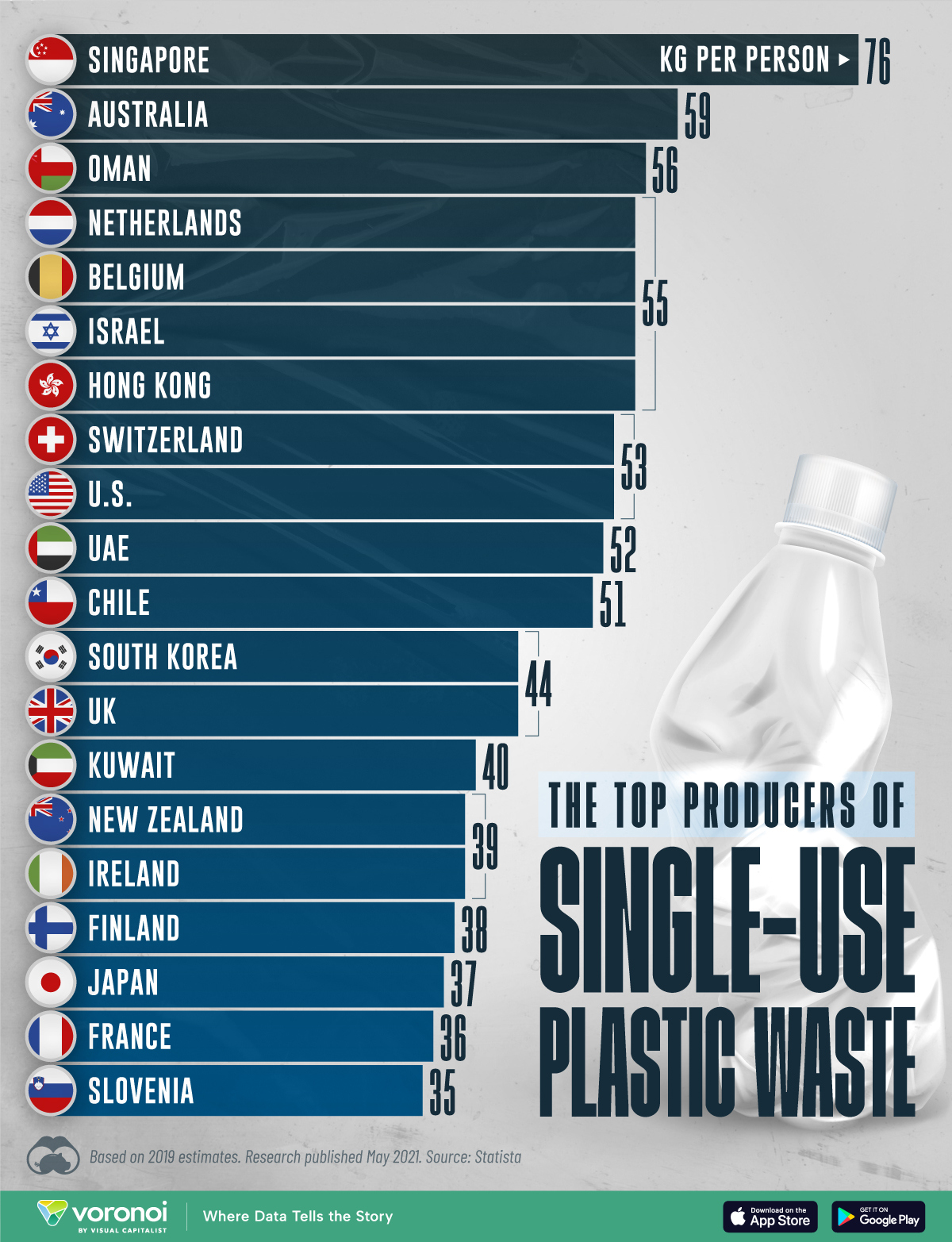Green
Visualizing Changes in CO₂ Emissions Since 1900
![]() Subscribe to the Elements free mailing list for more like this
Subscribe to the Elements free mailing list for more like this
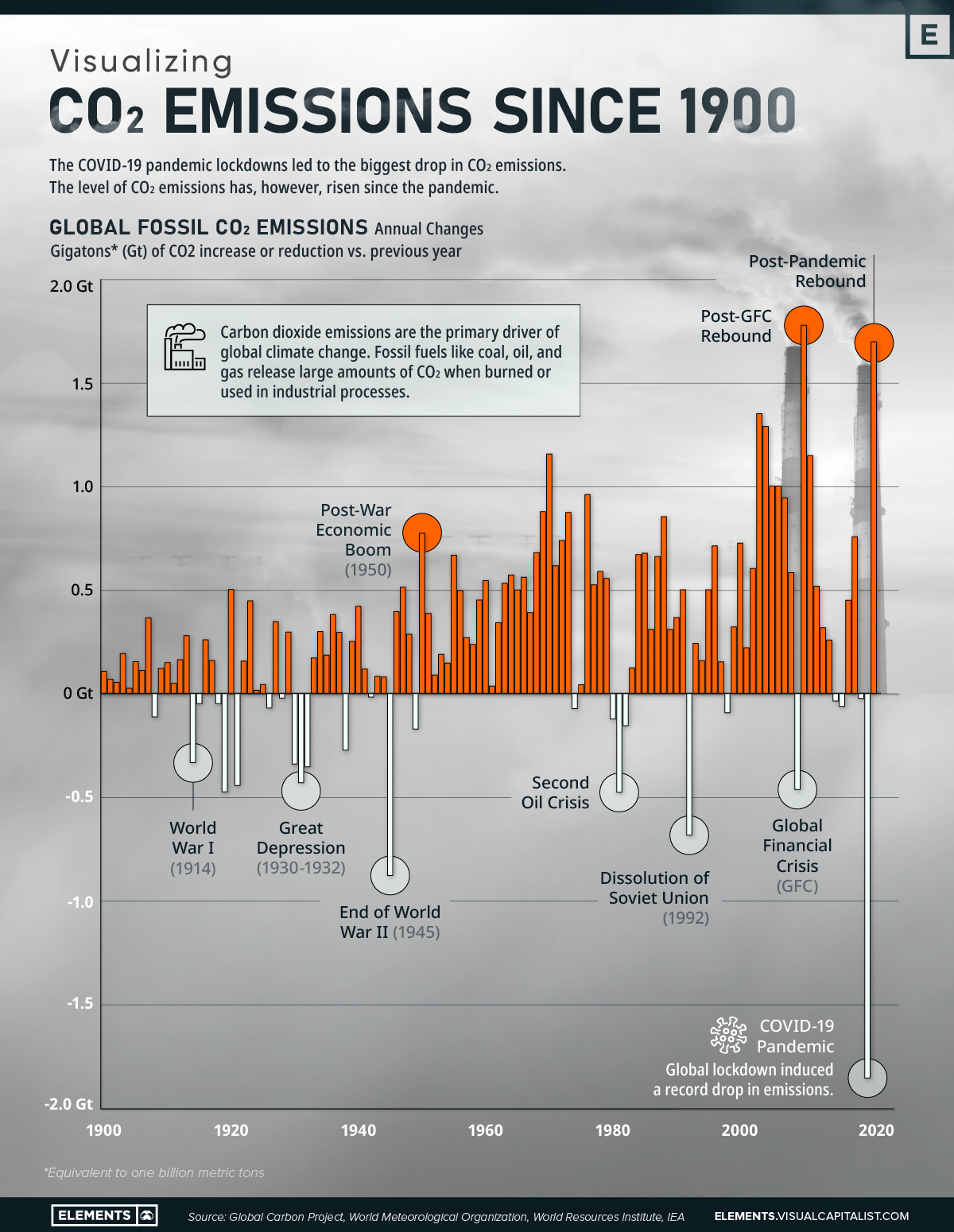
Visualizing CO₂ Emissions Since 1900
This was originally posted on Elements. Sign up to the free mailing list to get beautiful visualizations on natural resource megatrends in your email every week.
Leaders from all over the world are currently gathering at the Conference of the Parties of the UNFCCC (COP 27) in Egypt to discuss climate action, and to negotiate the commitments being made by countries to the global climate agenda.
This visualization based on data from the Global Carbon Project shows the changes in global fossil fuel carbon dioxide (CO₂) emissions from 1900 to 2020, putting the challenge of fighting climate change into perspective.
Cumulative CO₂ Emissions vs. Rate of Change
Global climate change is primarily caused by carbon dioxide emissions. Fossil fuels like coal, oil, and gas release large amounts of CO₂ when burned or used in industrial processes.
Before the Industrial Revolution (1760-1840), emissions were very low. However, with the increased use of fossil fuels to power machines, emissions rose to 6 billion tonnes of CO₂ per year globally by 1950. The amount had almost quadrupled by 1990, reaching a rate of over 22 billion tonnes per year.
Currently, the world emits over 34 billion tonnes of CO₂ each year. Since 1751, the world has emitted over 1.5 trillion tonnes of CO₂ cumulatively.
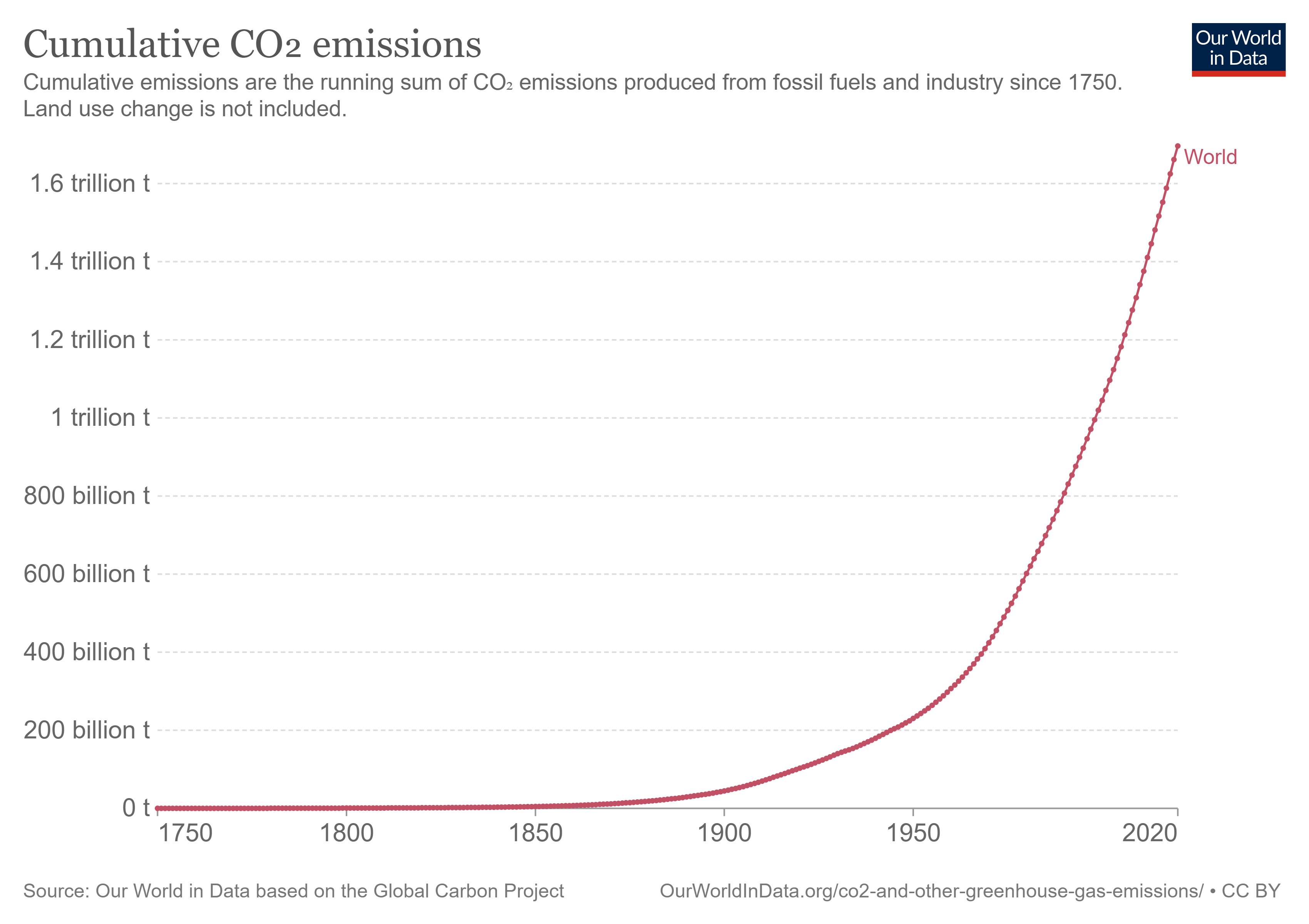
Prior to the COVID-19 pandemic, average global growth in fossil CO₂ emissions had slowed to 0.9% annually during the 2010s, reaching 36.7 gigatons of CO₂ added to the atmosphere in 2019.
However, in 2020, global lockdowns led to the biggest decrease in CO₂ emissions ever seen in absolute terms. Global fossil CO₂ emissions decreased by 5.2% to 34.8 gigatons, mainly due to halts in aviation, surface transport, power generation, and manufacturing during the pandemic.
Since then, emissions have approached pre-pandemic levels, reaching 36.2 gigatons added to the atmosphere in 2021.
Biggest Emitters, by Country
Asia, led by China, is the largest emitter, with the continent accounting for more than half of global emissions.
| Rank | Country | 2020 CO₂ Emissions (Millions of metric tons) |
|---|---|---|
| #1 | 🇨🇳 China | 10,668 |
| #2 | 🇺🇸 United States | 4,713 |
| #3 | 🇮🇳 India | 2,442 |
| #4 | 🇷🇺 Russia | 1,577 |
| #5 | 🇯🇵 Japan | 1,031 |
| #6 | 🇮🇷 Iran | 745 |
| #7 | 🇩🇪 Germany | 644 |
| #8 | 🇸🇦 Saudi Arabia | 626 |
| #9 | 🇰🇷 South Korea | 598 |
| #10 | 🇮🇩 Indonesia | 590 |
| #11 | 🇨🇦 Canada | 536 |
| #12 | 🇧🇷 Brazil | 467 |
| #13 | 🇿🇦 South Africa | 452 |
| #14 | 🇹🇷 Turkey | 393 |
| #15 | 🇦🇺 Australia | 392 |
CO₂ emissions from developing economies already account for more than two-thirds of global emissions, while emissions from advanced economies are in a structural decline.
Coal Power Generation Set for Record Increase
To avoid the worst impacts of climate change, more than 130 countries have now set or are considering a target of reducing emissions to net zero by 2050.
Much of the slowdown in emissions growth in the 2010s was attributable to the substitution of coal—the fuel that contributes most to planet-warming emissions—with gas and renewables. In addition, during the previous COP26 held in Glasgow, 40 nations agreed to phase coal out of their energy mixes.
Despite that, in 2021, coal-fired electricity generation reached all-time highs globally and is set for a new record in 2022 as consumption surged in Europe to replace shortfalls in hydro, nuclear, and Russian natural gas.
As leaders meet in Egypt for the world’s largest gathering on climate action, it will be up to them to come up with a plan for making their environmental aspirations a reality.
Green
Ranked: Top 20 Countries by Plastic Waste per Capita
Visualizing plastic waste per capita reveals a surprising list of countries that you may not have expected.
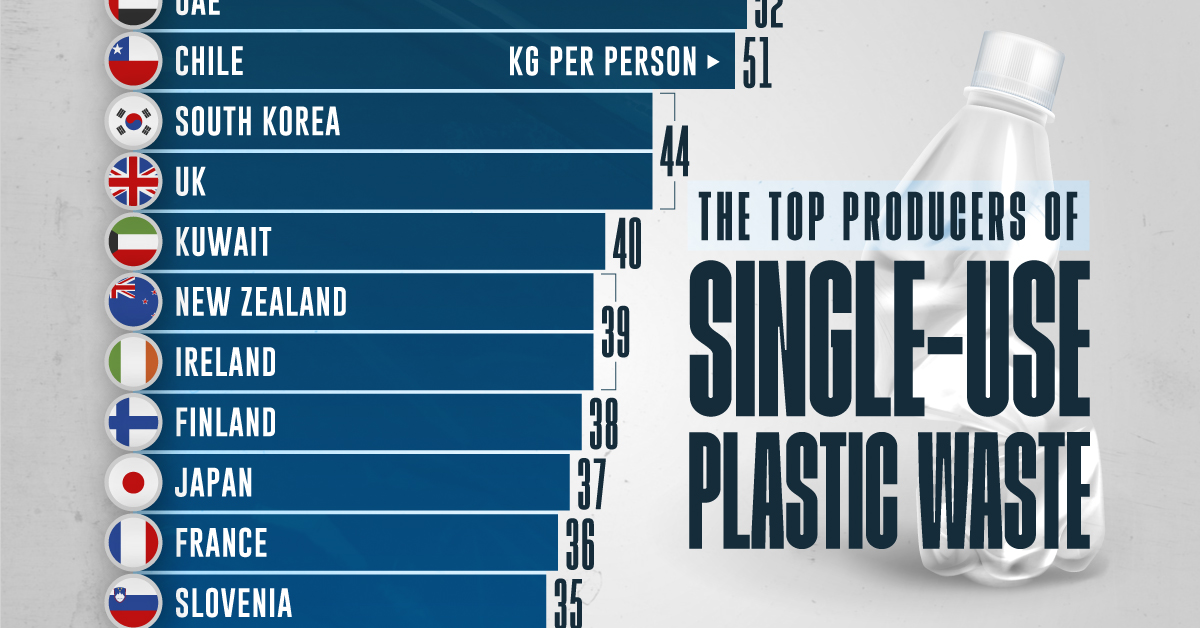
Ranked: Top 20 Countries by Plastic Waste per Capita
This was originally posted on our Voronoi app. Download the app for free on iOS or Android and discover incredible data-driven charts from a variety of trusted sources.
Single-use plastic waste is perhaps one of the biggest environmental issues of our time. Every year, millions of tons of plastic end up in oceans and landfills, harming wildlife and ecosystems.
To make matters worse, plastics take hundreds of years to decompose, leading to long-term environmental and health hazards as they break down into microplastics that contaminate water and food sources.
In this graphic, we visualized the top 20 countries that generated the most single-use plastic waste per capita in 2019, measured in kilograms per person. Figures come from research published in May 2021, which we sourced from Statista.
Data and Key Takeaways
The data we used to create this graphic is listed in the table below.
| Rank | Country | Kg per person | Pounds per person |
|---|---|---|---|
| 1 | 🇸🇬 Singapore | 76 | 168 |
| 2 | 🇦🇺 Australia | 59 | 130 |
| 3 | 🇴🇲 Oman | 56 | 123 |
| 4 | 🇳🇱 Netherlands | 55 | 121 |
| 5 | 🇧🇪 Belgium | 55 | 121 |
| 6 | 🇮🇱 Israel | 55 | 121 |
| 7 | 🇭🇰 Hong Kong | 55 | 121 |
| 8 | 🇨🇭 Switzerland | 53 | 117 |
| 9 | 🇺🇸 U.S. | 53 | 117 |
| 10 | 🇦🇪 UAE | 52 | 115 |
| 11 | 🇨🇱 Chile | 51 | 112 |
| 12 | 🇰🇷 S. Korea | 44 | 97 |
| 13 | 🇬🇧 UK | 44 | 97 |
| 14 | 🇰🇼 Kuwait | 40 | 88 |
| 15 | 🇳🇿 New Zealand | 39 | 86 |
| 16 | 🇮🇪 Ireland | 39 | 86 |
| 17 | 🇫🇮 Finland | 38 | 84 |
| 18 | 🇯🇵 Japan | 37 | 82 |
| 19 | 🇫🇷 France | 36 | 79 |
| 20 | 🇸🇮 Slovenia | 35 | 77 |
Countries from all around the world are present in this ranking, highlighting how plastic waste isn’t concentrated in any one region.
It’s also interesting to note how most of the countries in this top 20 ranking are wealthier, more developed nations. These nations have higher levels of consumption, with greater access to packaged goods, take-out services, and disposable products, all of which rely on single-use plastics.
Where’s China and India?
Note that we’ve visualized plastic waste per capita, which is different from the total amount of waste produced by a country. It is for this reason that major polluters, such as China and India, are not present in this ranking.
It’s also worth noting that this focuses on the demand side of plastics, rather than where plastic products were initially created or produced.
If you’re interested to see more visuals on plastic waste, check out Which Countries Pollute the Most Ocean Plastic Waste?.
-

 Economy5 days ago
Economy5 days agoRanked: The Countries Most Dependent on Agricultural Exports
-

 Technology2 weeks ago
Technology2 weeks agoVisualizing the Training Costs of AI Models Over Time
-
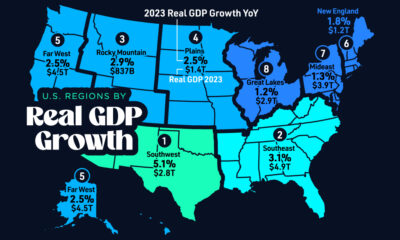
 Economy2 weeks ago
Economy2 weeks agoMapped: The Real GDP Growth of U.S. Regions in 2023
-

 Technology2 weeks ago
Technology2 weeks agoCharted: How Many Data Centers do Major Big Tech Companies Have?
-

 Globalization1 week ago
Globalization1 week agoCharted: Countries Offering Digital Nomad Visas
-

 Politics1 week ago
Politics1 week agoMapped: Unauthorized Immigrants by State
-

 Technology1 week ago
Technology1 week agoVisualizing the 15 Most Valuable Bitcoin Addresses
-

 Demographics1 week ago
Demographics1 week agoWhich Countries Have the Most and Least Women in the Workforce?




